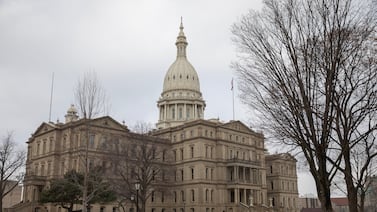Sign up for Chalkbeat Newark’s free newsletter to get the latest news about the city’s public school system delivered to your inbox.
After Newark Public Schools fell short on student achievement in standardized tests several years running, the state stepped in and put the district on an improvement plan that outlined clearly defined metrics needed to show student progress.
That was nearly a year ago. Now, the most recent round of New Jersey Student Learning Assessment results showed little change, once again, with the overwhelming majority of Newark students still performing below grade-level proficiency in reading, math, and science.
That means the district will remain under the watch of the Essex County executive superintendent, a proxy for the state education department, who is mandated to step in to evaluate the district’s progress every six months. The oversight carries echoes of the district’s 25 years under state control, which was lifted five years ago amid the pandemic.
Newark’s state-approved improvement plan goals are lofty by some measures and modest by others. They include year-over-year objectives to improve proficiency rates in reading by 4 percentage points, math by 8 percentage points, and science by 3 percentage points, in addition to increasing the graduation rate by 1.5 percentage points, and decreasing chronic absenteeism by half of a percentage point.
Based on publicly available state and district data, Newark succeeded in only one of those goals — decreasing its chronic absenteeism rate from 12.7% in 2023 to 12.1% in 2024. The state defines chronic absenteeism as missing 10% of the school year, or 18 days in a 180-day school year.
A Newark Public Schools spokesman did not respond to a request for comment on the district’s current standing under the improvement plan. According to state statute, if the district’s performance drastically worsens while under the improvement plan, that could trigger partial or full state intervention, though insufficiencies in several other areas would also need to be met.
Some critics of the state’s evaluation system argue that measuring a district’s performance on student outcomes in state tests doesn’t accurately represent how well it’s teaching students.
“You’re judging the quality of the school district based on metrics that are not entirely dependent on how the school is doing,” said Mark Weber, an education policy analyst at New Jersey Policy Perspective and lecturer at Rutgers University. “If you have a district that has a high poverty rate, that’s going to affect test scores, and the district is being judged on that.”
An interim review in June showed the district still wasn’t meeting state standards, according to documents Chalkbeat Newark obtained through a public records request. Based on the six-month guideline in the state statute, a subsequent review was due in December, but it had not been completed yet as of this week, state education department spokesman Michael Yaple said Tuesday.
The district will remain under an improvement plan status, Yaple added, until it either satisfies the goals in the next interim review or it meets state standards in the comprehensive review due in the 2025-26 school year.
The dire landscape of student achievement in Newark hasn’t significantly changed in the last three rounds of state testing since the COVID pandemic disrupted learning.
State test results released in December showed an overwhelming majority of students in the district are still struggling to perform on grade level in key subjects. Nearly 70% of students in grades 3-9 are falling short of meeting literacy benchmarks, around 82% aren’t meeting math standards, and 93% of fifth graders are below grade-level in science.
The results showed limited increases over 2023, highlighting Newark’s slow recovery from pandemic-era learning upheaval. Over the last few years with the help of federal pandemic relief funds, Superintendent Roger León ramped up tutoring efforts with summer and Saturday programs. The district allocated $6.8 million for tutoring this school year, offering extra tutoring sessions from the start of the school year.
But some of those tutoring efforts are at risk of being scaled back next year, as the district no longer has access to those federal dollars, which expired in September.
Evaluation score dips below standard, but not at historically low levels
The state Department of Education reviews a district’s overall performance every three years based on five key categories in its evaluation system — the Quality Single Accountability Continuum — which includes instruction, fiscal management, governance, operations, and personnel. Under each category, there are several ways districts get judged using a scale of 100 points to determine how well they’re meeting the standards outlined. When a district falls below the minimum passing score of 80 in any given category, it’s mandated to create a district improvement plan with state approval and oversight.
Newark was due for its state review in the 2022-23 school year for the first time since it regained full local control in 2020. The district gave itself high marks in all categories, but, in late 2023, the state gave the district a score of 79 for instruction, particularly docking points as it related to student achievement, graduation rates, and chronic absenteeism.
Joseph Zarra, the interim Essex County executive superintendent, conducted a six-month review in June and knocked two additional points from the district’s instruction score to a 77 due to its failure to meet goals in the improvement plan, state documents showed.
Newark Public Schools spokesman Paul Brubaker did not respond to questions about the district’s struggle to meet its improvement plan goals.
Though the district remains under an improvement plan, the reasons are starkly different from what led to state control in 1995 when staggeringly low student achievement levels contrasted exorbitantly high spending among district leaders. It was during the state’s 25-year takeover, that the education department’s evaluation system was created and then used to determine the district’s readiness in its transition back to local control.
Critics say evaluation system favors wealthier districts
Once the district regained local control in 2020, it faced a steep hurdle as students citywide were disproportionately affected by remote learning during COVID-19 shutdowns due to limited internet access, lack of laptops or digital tablets at home, and barriers to resources for students with disabilities, among other issues.
The pandemic came soon after the district was already seeing student performance on state test scores slide back after years of improvement.
With the influx of $287 million in federal relief funding, district leaders earmarked large sums of those funds to fix up its dilapidated school buildings, with a smaller proportion going toward increased tutoring efforts. Newark wasn’t alone in those decisions, as many high-poverty school districts spent the funds similarly.
Critics of the state’s evaluation system point to the underlying inequities in the system, saying that critiques of a high-needs district like Newark based on student outcomes in state tests don’t account for factors that contribute to low student achievement, such as poverty.
“For a district that starts with lower test scores, it’s harder to show growth,” said Weber, the Rutgers lecturer, adding that the district has also seen an influx of English language learners in recent years who require additional resources.
“Is it rational and reasonable to expect the district to get the same scores as another district that doesn’t have, let’s say, as many English language learners?” Weber said. “Because of this reliance on test score outcomes to determine whether you’re in need of correction or not, you’ve inherently got a bias against a district like Newark, Paterson, Trenton, and Camden. That’s problematic.”
Other categories in the evaluation system, such as governance and operations, are solely based on policies and practices in place.
“Those are things that the school district could directly control. Student outcomes are not,” Weber said.
In recent months, school leaders statewide have urged the state Board of Education to change the system’s emphasis on student outcomes, which they say favors wealthier districts. In October, Acting Education Commissioner Kevin Dehmer reported a notice to the state school board that of 56 total district performance reviews conducted during that period, 42 districts didn’t meet state standards, largely due to shortcomings in academic achievement.
If Newark still doesn’t meet the goals outlined in its improvement plan over the next six months, the state will do a comprehensive review in the 2025-26 school year, and determine at that point if a new improvement plan should be implemented, according to state statute.
The district could face partial state intervention if its score in any of the five evaluation categories falls below 50 points and it fails to implement the improvement plan, according to state statute. If additional circumstances are also preventing the district from providing a thorough and efficient education, as the state’s constitution mandates, then the education commissioner could invoke full state intervention, the statute says.
Catherine Carrera is the bureau chief for Chalkbeat Newark. Contact Catherine at ccarrera@chalkbeat.org.





